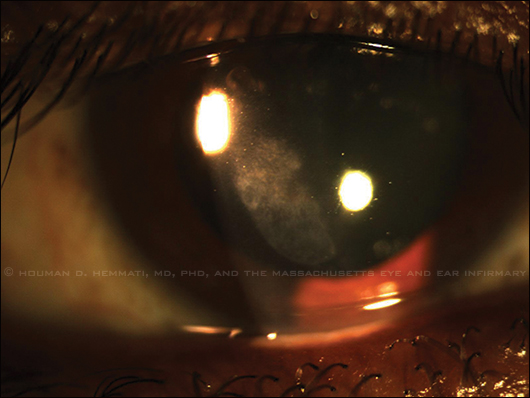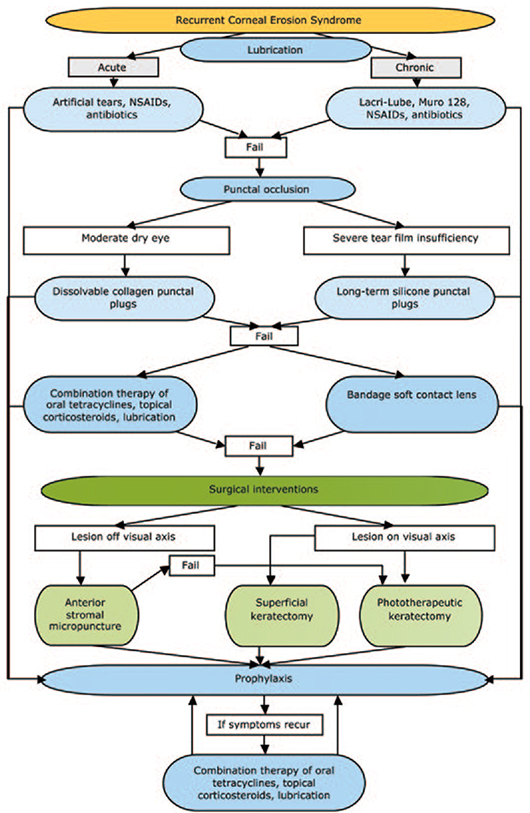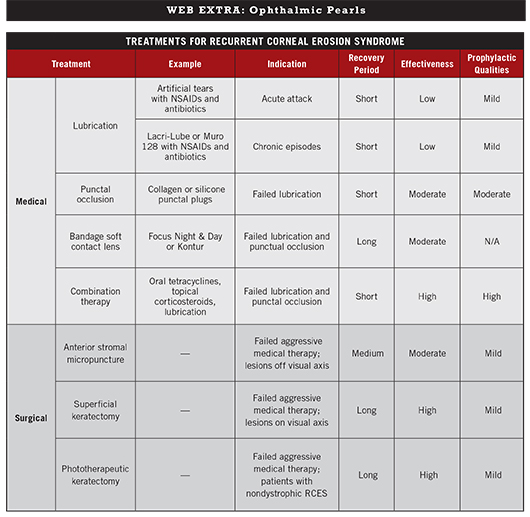By Raj Thakrar, MS, and Houman D. Hemmati, MD, PhD
Edited by Ingrid U. Scott, MD, MPH, and Sharon Fekrat, MD
Download PDF
Recurrent corneal erosion syndrome (RCES) is a common clinical disorder involving the corneal epithelium and epithelial basement membrane. Characterized by the repeated breakdown of epithelium, RCES can cause moderate to severe eye pain, photophobia, lacrimation, and corneal scarring leading to visual changes. Patients are often debilitated by the resulting pain and visual deficits and frustrated by the condition’s lack of response to treatment.
This review presents a spectrum of treatments for RCES, ranging from simple medical management to complex surgical interventions. The stepladder approach will guide ophthalmologists to individualize treatment, minimize iatrogenic risks, and improve long-term outcomes.
 |
|
CLASSIC PRESENTATION. A patient with recurrent corneal erosion syndrome. Episodes of corneal erosion arise from detachment of the epithelium from the underlying epithelial basement membrane.
|
Etiology
In a study of 104 RCES cases, trauma contributed to 45 percent, epithelial basement membrane dystrophy (EBMD) contributed to 29 percent, and a combination of trauma and EMBD contributed to 17 percent of cases.1
As a category, trauma includes mechanical trauma to the corneal surface. The subsequent inflammation from these injuries can cause disruption in the extracellular adhesion in the corneal epithelium. Matrix metalloproteinases have been implicated in degrading these scaffolding proteins, resulting in erosion.2
Patients with EBMD, a congenital condition, have an anterior epithelium that does not adhere well to the basement membrane due to morphological changes in the epithelial cells or basement membrane matrix.1 This creates a loose epithelial layer prone to shifting and tearing when damaged.
Adhesions between the palpebral conjunctiva of the eyelids and the corneal epithelium in dry eye patients contribute significantly to RCES in many patients. Individuals with ocular rosacea are particularly at risk due to meibomian gland dysfunction and resultant evaporative dry eye.
|
Treatment Algorithm for RCES
|
 |
Treatment Options
Owing to the recurrent nature of this condition and its resistance to commonly used therapies, patients often make repeated visits to their ophthalmologists. There are many treatment options for RCES, each of which has varying degrees of efficacy. Patients must be assessed on a case-by-case basis so that treatment regimens are individualized. We have devised a management algorithm for the treatment of RCES (see “Treatment Algorithm for RCES”).
Medical. Medical treatment options should be explored before resorting to more invasive surgical alternatives.
- Lubrication. This is considered first-line therapy, and we recommend frequent application of preservative-free artificial tears combined with a lubricating ointment at bedtime (or more frequently, as needed) to prevent the eyelid from adhering to the corneal epithelium. For patients needing pain relief, these agents may be chilled.
For patients with chronic RCES, we recommend the nighttime application of a prophylactic bland ointment, such as Refresh PM or Lacri-Lube, or hypertonic saline, such as Muro 128. For recovering patients whose epithelium is healing, we recommend bland ointment to prevent surface aggravation.
- Antibiotics and pain relievers. For patients in the midst of an acute attack with an epithelial defect on examination, we recommend an antibiotic-containing ointment, such as erythromycin or bacitracin, to retard bacterial infection, and oral NSAIDs, such as ibuprofen, for pain. Those with severe pain may be prescribed oral narcotics such as hydrocodone. Antibiotics and NSAIDs also are appropriate for chronic cases of RCES.
- Punctal occlusion. For chronic dry eye patients whose RCES is resistant to lubrication alone, punctal occlusion may be performed. This simple, one-time intervention can promote more rapid healing and prevent further attacks by increasing the ocular surface residence time of both natural and exogenously applied tears. As a trial, especially in patients with mild to moderate dry eye, a dissolvable short-term collagen punctal plug may be used. However, in patients with severe tear film insufficiency, we recommend longer-term silicone punctal plugs.
- Bandage soft contact lens. Patients who are unresponsive to lubrication or have large erosions may benefit from an extended-wear bandage soft contact lens (BCL), such as Focus Night & Day or Kontur, in the affected eye for two to eight weeks, with a prophylactic topical antibiotic, such as ofloxacin, applied twice a day.3 This intervention is particularly useful for patients in whom meibomian gland dysfunction and ocular rosacea are not significant contributing factors. In a small retrospective study, 75 percent of patients who underwent BCL placement had no recurrence of RCES symptoms for one year after treatment.3
- Combination therapy. An alternative to BCL placement, particularly for patients with meibomian gland dysfunction or ocular rosacea, is combination therapy with topical lubrication, oral tetracyclines, and a topical corticosteroid. In one retrospective study, seven patients who took 50 mg oral doxycycline twice daily and applied a topical steroid such as methylprednisolone 1 percent twice or more daily for three weeks demonstrated marked improvement, including a decrease in pain, improvement in visual acuity, and no recurrence of RCES symptoms during a mean follow-up period of almost two years. Both doxycycline and methylprednisolone inhibit matrix metalloproteinase-9, which is implicated in cleaving scaffolding proteins in the corneal epithelial basement membrane.2 This inhibition can aid the recovery and reattachment of the corneal epithelium following RCES.
We also recommend the frequent application of preservative-free artificial tears during the day and bland ointment or hypertonic saline ointment at bedtime to promote recovery, especially in patients with dry eye or ocular rosacea. If this regimen fails, surgery may be considered.
Surgical. Due to the attendant risks, surgery should be reserved for patients who have failed aggressive medical therapies. It should not be performed as an initial form of treatment.
- Anterior stromal micropuncture. ASP may be considered for lesions outside the visual axis because it is a rapid procedure that can be performed in the office. Under a slit lamp, a bent 20- to 25-gauge hypodermic needle is used to make several punctures through the anterior corneal epithelium and Bowman’s layer and into the anterior stroma. These micropunctures elicit a fibrocytic response and rapid basement membrane production, which anchor the corneal epithelium in place.4
It should be noted that ASP has fallen out of favor as a surgical treatment for RCES in many practices, as it can cause scarring, glare, and blurred vision, and has a high failure rate in preventing further erosions.
- Debridement and superficial keratectomy. For patients with lesions in the visual axis, debridement and superficial keratectomy may be performed with either a number 15 scalpel or diamond burr. Although this is a relatively rapid outpatient procedure, it is more invasive than ASP. Under topical anesthesia, sterile forceps or ophthalmic sponges are used to clear away the loose anterior epithelium. The surrounding epithelium is then debrided, leaving a rim of corneal epithelium for re-epithelialization. The depth of the keratectomy should reach the anterior portion of Bowman’s layer. After surgery, a BCL should be placed until re-epithelialization has been achieved, with topical antibiotics applied up to four times daily.
- Phototherapeutic keratectomy. This may be considered for patients for whom all other treatments have failed. PTK is also indicated in patients with macroerosions, which are often associated with nondystrophic RCES following ocular trauma. In PTK, an excimer laser is used to ablate 5 to 10 µm of Bowman’s layer after mechanical debridement of the overlying corneal epithelium. Like superficial keratectomy, this allows the cornea to re-epithelialize with stronger adhesion to the basement membrane. We recommend placement of a BCL and administration of topical antibiotics and corticosteroids, such as fluorometholone acetate 1 percent, two to four times daily after ablation. In a retrospective study of 76 eyes, PTK was used to treat RCES, with a recurrence rate of 11 percent.5
We advise that all patients who are treated surgically be monitored postoperatively with a follow-up appointment scheduled two to four weeks after the procedure. If symptoms have improved or are completely eliminated, we recommend prophylactic treatment with lubrication as described above to prevent a recurrence. If symptoms recur, oral doxycycline and topical steroids may be administered twice daily for two to three weeks.
(click to expand)

Conclusion
Several options exist for treating RCES. However, the underlying condition, if overlooked, can result in recurrent erosions and debilitating symptoms. Based on clinical evidence, combination therapy with oral tetracycline, topical corticosteroids, and lubrication is the most effective treatment for RCES. For severe and refractory cases of RCES, superficial keratectomy and PTK may also be effective.
___________________________
1 Reidy JJ et al. Cornea. 2000;19(6):767-771.
2 Dursun D et al. Am J Ophthalmol. 2001;132(1):8-13.
3 Fraunfelder FW, Cabezas M. Cornea. 2011;30(2):164-166.
4 Das S, Seitz B. Surv Ophthalmol. 2008;53(1):3-15.
5 Maini R, Loughnan MS. Br J Ophthalmol. 2002;86(3):270-272.
___________________________
Mr. Thakrar is a medical student and Dr. Hemmati is assistant professor of ophthalmology and surgery; both are at the University of Vermont in Burlington. The authors report no related financial interests.